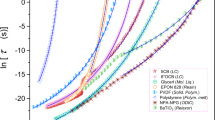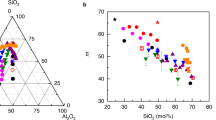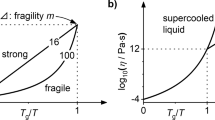Abstract
Glass is a microscopically disordered, solid form of matter that results when a fluid is cooled or compressed in such a manner that it does not crystallize. Almost all types of materials are capable of glass formation, including polymers, metal alloys and molten salts. Given such diversity, general principles by which different glass-forming materials can be systematically classified are invaluable. One such principle is the classification of glass-formers according to their fragility1. Fragility measures the rapidity with which a liquid's properties (such as viscosity) change as the glassy state is approached. Although the relationship between the fragility, configurational entropy and features of the energy landscape (the complicated dependence of energy on configuration) of a glass-former have been analysed previously2, a detailed understanding of the origins of fragility is lacking. Here I use simulations to analyse the relationship between fragility and quantitative measures of the energy landscape for a model liquid whose fragility depends on its bulk density. The results reveal that fragility depends on changes in the vibrational properties of individual energy minima in addition to their total number and spread in energy. A thermodynamic expression for fragility is derived, which is in quantitative agreement with kinetic fragilities obtained from the liquid's diffusivity.
This is a preview of subscription content, access via your institution
Access options
Subscribe to this journal
Receive 51 print issues and online access
$199.00 per year
only $3.90 per issue
Buy this article
- Purchase on Springer Link
- Instant access to full article PDF
Prices may be subject to local taxes which are calculated during checkout



Similar content being viewed by others
References
Angell, C. A. Relaxation in liquids, polymers and plastic crystals—Strong/fragile patterns and problems. J. Non-Cryst. Solids 131–133 , 13–31 (1991).
Speedy, R. J. Relations between a liquid and its glasses. J. Phys. Chem. B 103, 4060–4065 (1999).
Laughlin, W. T. & Uhlmann, D. R. Viscous flow in simple organic liquids. J. Phys. Chem. 76, 2317–2325 (1972).
Adam, G. & Gibbs, J. H. On the temperature dependence of cooperative relaxation properties in glass-forming liquids. J. Chem. Phys. 43, 139–146 (1965).
Angell, C. A. Entropy and fragility in supercooled liquids. J. Res. NIST 102, 171–185 (1997).
Kob, W. & Andersen, H. C. Testing mode-coupling theory for a supercooled binary Lennard–Jones mixture: The van Hove correlation function. Phys. Rev. E 51, 4626– 2641 (1995).
Sastry, S., Debenedetti, P. G. & Stillinger, F. H. Signatures of distinct dynamical regimes in the energy landscape of a glass-forming liquid. Nature 393, 554–557 (1998).
Sciortino, F., Kob, W. & Tartaglia, P. Inherent structure entropy of supercooled liquids. Phys. Rev. Lett. 83, 3214–3217 (1999).
Coluzzi, B., Parisi, G. & Verrocchio, P. Lennard–Jones binary mixture: a thermodynamical approach to glass transition. J. Chem. Phys. 112, 2933–2944 (2000).
Sastry, S. Liquid limits: The glass transition and liquid–gas spinodal boundaries of metastable liquids. Phys. Rev. Lett. 85, 590–5593 (2000).
Ito, K., Moynihan, C. T. & Angell, C. A. Thermodynamic determination of fragility in liquids and a fragile-to-strong liquid transition in water. Nature 398, 492–495 (1999).
Xia, X. & Wolynes, P. G. Fragilities of liquids predicted from the random first order transition theory of glasses. Proc. Natl Acad. Sci. USA 97, 2990–2994 (2000).
Stillinger, F. H. & Weber, T. A. Packing structures and transitions in liquids and solids. Science 225, 983–989 (1984).
Stillinger, F. H. A topographic view of supercooled liquids and glass formation. Science 267, 1935–1939 ( 1995).
Buechner, S. & Heuer, A. The potential energy landscape of a model glass former: thermodynamics, anharmonicities, and finite size effects. Phys. Rev. E 60, 6507– 6518 (1999).
Speedy, R. J. The hard sphere glass transition. Mol. Phys. 95, 169–178 (1998).
Scala, A., Starr, F. W., La Nave, E., Sciortino, F. & Stanley, H. E. Configurational entropy and diffusivity of supercooled water. Nature 406, 166– 169 (2000).
Sastry, S. Evaluation of configurational entropy of a model liquid from computer simulations. Proceedings of Unifying Concepts in Glass Physics, Triest, 1999. J. Phys. Cond. Mat. 12, 6515–6524 (1996).
Speedy, R. J. & Debenedetti, P. G. The distribution of tetravalent network glasses. Mol. Phys. 88, 1293– 1316 (1996).
Goldstein, M. Viscous liquids and the glass transition. V. Sources of the excess specific heat of the liquid. J. Chem. Phys. 64, 4767 –4774 (1976).
Angell, C. A. & Rao, K. J. Configurational excitations in condensed matter and the bond lattice model for the liquid-glass transition. J. Chem. Phys. 57, 470–481 (1972).
Angell, C. A. Ten questions on glassformers, and a real space “excitations” model with some answers on fragility and phase transitions. Proceedings of Unifying Concepts in Glass Physics, Trieste, 1999. J. Phys. Cond. Mat. 12, 6463–6476 ( 2000).
Green, J. L., Ito, K., Xu, K. & Angell, C. A. Fragility in liquids and polymers: new, simple quantifications and interpretations. J. Phys. Chem. B 103, 3991–3996 (1999).
Johari, G. P. A resolution for the enigma of a liquid's configurational entropy–molecular kinetics relation. J. Chem. Phys. 112, 8958 –8969 (2000).
Johari, G. P. Contributions to the entropy of a glass and liquid, and the dielectric relaxation time. J. Chem. Phys. 112, 7518– 7523 (2000).
Yamamuro, O. et al. Calorimetric study of glassy and liquid toluene and ethylbenzene: thermodynamic approach to spatial heterogeneity in glass-forming molecular liquids. J. Phys. Chem. B 102, 1605– 1609 (1998).
Ngai, K. L. & Yamamuro, O. Thermodynamic fragility and kinetic fragility in supercooled liquids: A missing link in molecular liquids. J. Chem. Phys. 111, 10403–10406 (1999).
Sciortino, F. & Tartaglia, P. Extension of the fluctuation–dissipation theorem to the physical aging of a model glass-forming liquid. Phys. Rev. Lett. (in the press).
Starr, F. W. et al. Thermodynamic and structural aspects of the potential energy surface of simulated water. Preprint http://arXiv.org/abs/cond-mat/0007487.
Heuer, A. & Buechner, S. Why is the density of inherent structures of a Lennard-Jones type system gaussian? Proceedings of Unifying Concepts in Glass Physics, Trieste, 1999. J. Phys. Cond. Mat. 12, 6535–6543 (2000).
Acknowledgements
I thank C. A. Angell, G. P. Johari, K. J. Rao, F. Sciortino, R. Seshadri, R. J. Speedy and U. V. Waghmare for useful discussions and/or comments on the manuscript.
Author information
Authors and Affiliations
Corresponding author
Rights and permissions
About this article
Cite this article
Sastry, S. The relationship between fragility, configurational entropy and the potential energy landscape of glass-forming liquids. Nature 409, 164–167 (2001). https://doi.org/10.1038/35051524
Received:
Accepted:
Issue Date:
DOI: https://doi.org/10.1038/35051524
This article is cited by
-
Electrofreezing of liquid water at ambient conditions
Nature Communications (2024)
-
Vogel–Fulcher–Tammann approach for the determination of fragility of polyisoprene (cis & trans) blend by activation energy: effect of fillers (aluminum and polyaniline)
Polymer Bulletin (2024)
-
Modern computational studies of the glass transition
Nature Reviews Physics (2023)
-
Entropy-driven atomic activation in supercooled liquids and its link to the fragile-to-strong transition
Science China Physics, Mechanics & Astronomy (2023)
-
The Effects of Attractive Interaction on Viscosity in Undercooled Kob–Andersen Liquids
Multiscale Science and Engineering (2023)
Comments
By submitting a comment you agree to abide by our Terms and Community Guidelines. If you find something abusive or that does not comply with our terms or guidelines please flag it as inappropriate.



